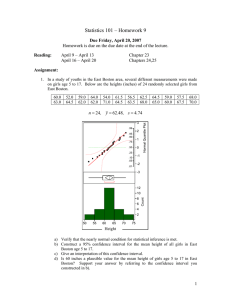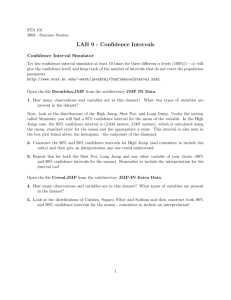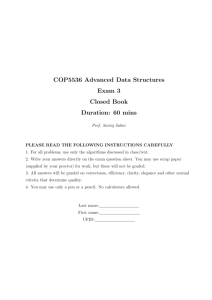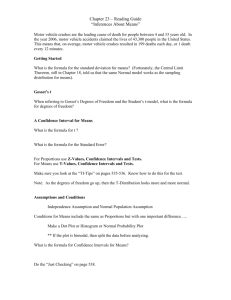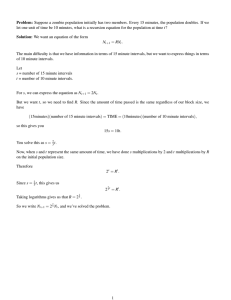Statistics 101 – Homework 9
advertisement
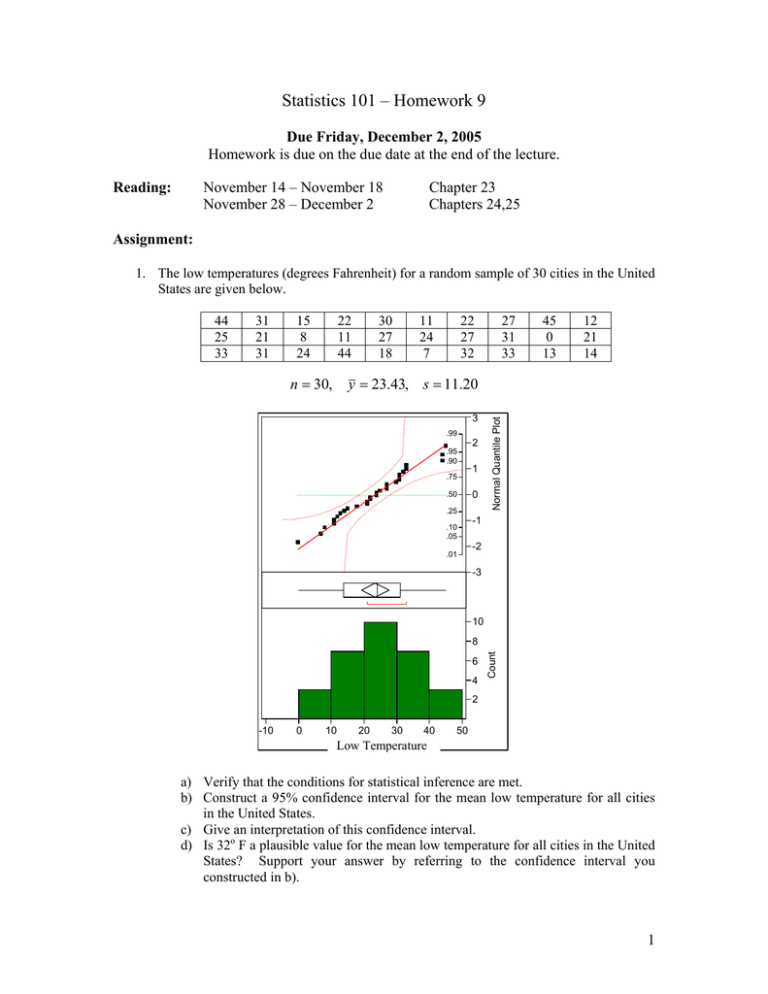
Statistics 101 – Homework 9 Due Friday, December 2, 2005 Homework is due on the due date at the end of the lecture. Reading: November 14 – November 18 November 28 – December 2 Chapter 23 Chapters 24,25 Assignment: 1. The low temperatures (degrees Fahrenheit) for a random sample of 30 cities in the United States are given below. 31 21 31 15 8 24 22 11 44 n = 30, 30 27 18 11 24 7 22 27 32 27 31 33 45 0 13 12 21 14 y = 23.43, s = 11.20 3 .99 .95 .90 .75 .50 .25 .10 .05 .01 2 1 0 Normal Quantile Plot 44 25 33 -1 -2 -3 10 6 4 Count 8 2 -10 0 10 20 30 40 50 Low Temperature a) Verify that the conditions for statistical inference are met. b) Construct a 95% confidence interval for the mean low temperature for all cities in the United States. c) Give an interpretation of this confidence interval. d) Is 32o F a plausible value for the mean low temperature for all cities in the United States? Support your answer by referring to the confidence interval you constructed in b). 1 2. Go to the following web site http://statweb.calpoly.edu/chance/applets/ConfSim/ConfSim.html For the method select Means. When you do this, a second box will appear with “z with sigma” in it. Go to the pull down for that box and select “t”. a) In the box labeled n, enter 10. In the box labeled intervals, enter 250. Click on Sample. Of the 250 intervals constructed how many contain the population mean, µ? b) In the box labeled conf level, change 95 to 90 and click on Recalculate. What do you notice about the width of the intervals now compared to those in a)? How many of the intervals contain the population mean, µ? c) In the box labeled conf level, change 90 to 98 and click on Recalculate. What do you notice about the width of the intervals now compared to those in b)? How many of the intervals contain the population mean, µ? d) What effect does changing the level of confidence have on the width of confidence intervals? e) Reset the simulation and enter 95 in the conf level box. Click on Sample. Now change the sample size from 10 to 100 in the box labeled n and click on Sample again. Describe the effect that changing the sample size from 10 to 100 has on the width of the confidence intervals. f) Click the Sample button enough times so that the running total is out of 5000. Report the value of the running total as a fraction and as a %. What should the long run running total be? 3. The local grocery store packages different grades (based on fat content) of hamburger. Usually the leaner (less fat) grades are more expensive. A simple random sample of 9 one-pound packages of hamburger is obtained from the local store and tested for fat content. Below are the percentages of lean meat for each package. 90.1 94.1 91.7 92.3 91.6 93.2 91.4 92.1 92.4 a) Calculate the sample mean percentage of lean meat and the sample standard deviation. b) The packages are labeled 93% lean. Use the summaries in a) to test the hypothesis H0: µ = 93 against HA: µ < 93, where µ is the population mean percentage lean. Be sure to calculate the appropriate test statistic and P-value, reach a decision and justify that decision, and state a conclusion. c) Based on the test in b), are the packages labeled correctly? Explain briefly. d) One of the conditions for the test in b) is that the random sample could have come from a population described by a normal model (the nearly normal condition). Use the sample data to construct a box plot. Does the shape of the box plot support the nearly normal condition? Explain briefly. 4. Data on the birth weight (grams) of 25 randomly selected male babies appear in the JMP file MaleBirthWeight.JMP on the course web page. Use JMP to analyze the distribution of birth weights and answer the following questions. Be sure to turn in a copy of the JMP output with your homework. a) Construct a 90% confidence interval for the population mean birth weight of male babies. b) Test the hypothesis that the population mean birth weight of male babies is 3600 grams against the alternative that the population mean birth weight is less than 3600 grams. Be sure to include all steps for the test of hypothesis. 2
